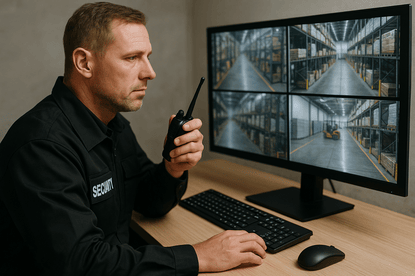
Transportation depots are buzzing with activity 24/7. You’ve got trucks refueling, employees clocking in and out, cargo being loaded or unloaded, and vendors coming and going—all at the same time. With so many moving parts, it’s no surprise that depots are prime targets for theft, tampering, and operational disruptions.
And yet, many depots are still relying on outdated cameras, generic access systems, and patchwork security coverage. At SSP, we know that keeping a depot secure takes more than a few cameras and a gate. It takes a strategic blend of access control, surveillance, and real-time visibility—designed around the way your depot actually operates.
Here’s how to protect what moves your business—fuel, freight, and people—without slowing it down.
l
l
The Challenge: Complex Movement, High-Risk Zones
A modern transportation depot is a unique environment. It’s not just a warehouse, a gas station, or a parking lot—it’s all of those things in one.
Each of these zones has different risks:
-
Fueling Areas: Prone to fuel theft, fire hazards, and unauthorized access
-
Freight Zones: Vulnerable to cargo theft, shrinkage, and tampering
-
Pedestrian Walkways & Time Clocks: At risk for unauthorized entry, time fraud, or safety incidents
-
Vehicle Gates: Frequent bottlenecks that need fast, secure throughput
-
Back Entrances / Service Areas: Often overlooked, but commonly exploited
These overlapping spaces demand layered, intelligent security that works in real time and supports operational flow—not one that slows it down.
l
l
Step 1: Create Role-Based Access Control for Staff and Vendors
Not everyone should be able to access every zone. With role-based access control, you assign permissions by job type—not by individual.
For example:
-
Drivers can access fueling stations and vehicle lots
-
Warehouse staff can access freight docks
-
Admin staff can only enter office zones
-
Vendors or contractors are limited to specific windows and entry points
Mobile credentials or access badges can be easily activated or revoked based on shifts or schedules. At SSP, we help depots design access systems that reflect real-world workflows—so you never have to worry about someone being in the wrong place at the wrong time.
l
l
Step 2: Use Smart Surveillance to Cover What Matters Most
Covering every inch of a depot with cameras isn’t realistic—or effective. Instead, smart camera placement and AI analytics let you monitor risk zones with precision.
Key areas to focus on:
-
Fuel pumps and fill stations
-
Loading docks and staging areas
-
Back gates and emergency exits
-
Time clock stations and entryways
-
Vehicle lots and idle truck zones
With video analytics, you can:
-
Detect loitering or unauthorized access
-
Monitor idle trucks after hours
-
Trigger alerts for movement in restricted areas
-
Automatically link footage to access events
This helps reduce theft, improve safety, and provide clear evidence when you need it—without watching dozens of feeds all day.
l
ll
Step 3: Automate Gate and Freight Movement Tracking with LPR
License Plate Recognition (LPR) systems help automate yard entry/exit and reduce bottlenecks at gates. Drivers don’t need to exit vehicles, swipe badges, or wait for clearance.
When integrated with access control, LPR enables:
-
Automatic entry for authorized fleet vehicles
-
Real-time alerts for unrecognized plates
-
Time-stamped logs of every vehicle movement
-
Visibility into fleet arrival/departure trends
For busy depots handling hundreds of vehicles a day, LPR saves time and dramatically increases transportation facility security.
l
l
Step 4: Don’t Overlook Pedestrian Safety and Identity Verification
Depots aren’t just for vehicles. You’ve got foot traffic, too—from drivers checking in to warehouse crews ending their shift.
Best practices:
-
Install surveillance near employee entrances, break areas, and walkways
-
Use access control with biometric or mobile ID at time clocks
-
Consider adding intercom systems at unmanned doors or contractor checkpoints
-
Ensure walkways are well-lit and monitored at night
These small improvements not only enhance security—they also support employee safety and reduce liability.
l
l
Step 5: Tie It All Together with Centralized Security Oversight
Busy depots can’t afford to waste time juggling disconnected systems. The smartest operations now use integrated platforms that combine:
-
Video surveillance
-
Access control
-
LPR
-
Emergency communication
-
Real-time alerts
-
Remote monitoring
At SSP, we help transportation facilities design and deploy centralized dashboards so you can monitor everything—whether it’s fuel inventory, freight movement, or who’s clocking in for a shift.
l
l
Final Thought: Don’t Let Complexity Become a Weakness
Transportation depots are high-value, high-activity spaces. With so much going on, it’s easy for security to fall behind. But with the right design—based on how your depot actually operates—you can protect every zone, every shift, and every load.
SSP delivers transportation facility security solutions that are practical, scalable, and proactive. From integrated access control to real-time video monitoring, we help logistics operators take control of their site without slowing it down.
Discover how SSP keeps transportation systems secure and operational.
Contact us today to schedule a depot security assessment.


